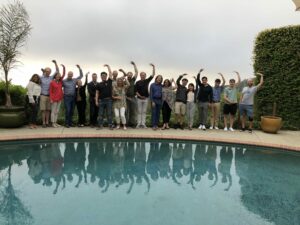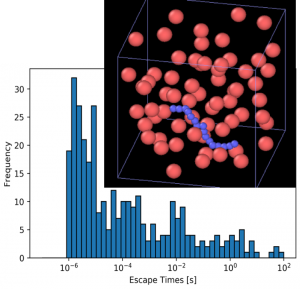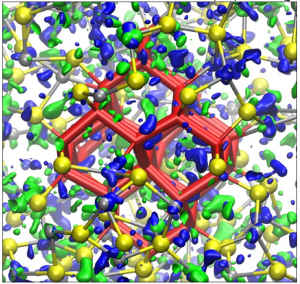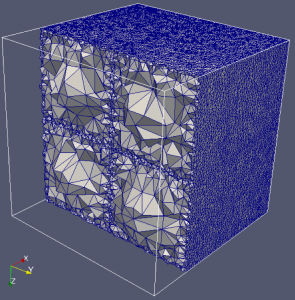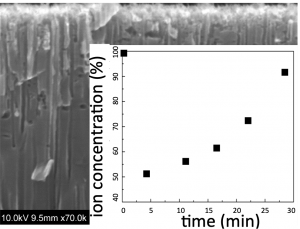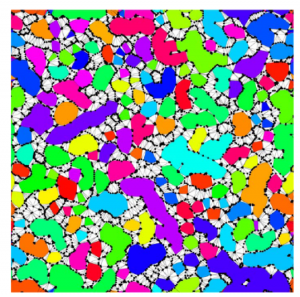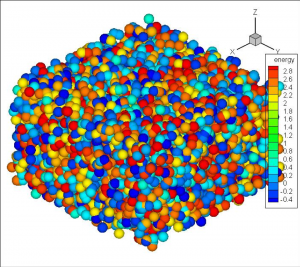The greatest moral and scientific challenge of our times is the climate crisis. Our group pursues research to address this crisis by creating new interfaces between basic science and applied science. In close collaboration with experimental groups, we develop complex theoretical methods for mitigating solar cell degradation, increasing solar cell efficiency, developing magnets for hybrid car engines, and inventing photovoltaic desalination.
Research Projects
Mitigating Solar Cell Degradation
What: Heterojunction (HJ) Si solar cells have world record efficiencies approaching 27%. However, these Si HJ solar cells have not yet been widely adopted by the market because they exhibit a performance degradation of about 1%/year, twice as high as standard cSi cells. Our group is adapting the knowledge developed via studying glassy systems to understand the leading degradation processes, with the aim of mitigating them.
How: LAMMPS molecular dynamics, Quantum Espresso DFT, Nudged Elastic Band method.
Increasing Solar Cell Efficiency
What: Our “Full Spectrum Boost Project” focuses on solar cells made of colloidal nanoparticles. Absorption is boosted at low energies by the Intermediate Band process and at high energies by Carrier Multiplication. Our cells transcend QCD: the Quantum Confinement Dilemma. Transport is modeled as ab initio-based Monte Carlo/Marcus hopping or Boltzmann theory.
How: LDA, TD-DFT, GW, BSE, Lanczos methods, Molecular Dynamics, Kinetic Monte Carlo
Magnets for Hybrid Car Engines
What: We are exploring the reversal mechanism of hard permanent magnets in order to improve their utility for alternative energy purposes. We study the competition of domain wall propagation and nucleation in sintered and nanostructured rare earth magnets. We are analyzing hard-soft composites.
How: Finite element LLG, FORC analysis: mean field + local corrections, OOMMF, analytic methods in one dimension, elastic rubber band method for barriers
Photovoltaic Desalination
What: We have invented photovoltaic desalination. We have provided the proof of concept experimentally. We are performing extensive simulations to analyze the dynamics of the desalination/flushing cycle, from the atomistic scale to simulating individual channels to building an effective medium theory for the device.
How: Finite element hydrodynamics, COMSOL hydrodynamics, effective medium theory
Glassy Systems
What: We are exploring the slow dynamics, the glassy phases and memory and aging effects of spin glasses, dislocation systems and Coulomb glasses. We also analyze the formation of avalanches and their statistics. Using scaling analysis, we research the conditions which give rise to Self Organized Criticality.
How: Parallel tempering and other accelerated Monte Carlo techniques, Scaling analysis
Memristors
What: We are exploring the revolutionary memristor paradigm that promises to redefine the architecture of computers. We study the electronic transport with explicit inclusion of underlying vacancy dynamics. We treat the long range Coulomb interaction with care. We focus on the hysteretic switching phenomena and explore the role of oxide tunneling barriers
How: Molecular Dynamics, Long range interactions
What’s New
Apr. 2024 Adam Goga passed his oral exam. With this, all four group members successfully passed their last exam at UC Davis. Congratulations to all!! A Burgers and Brew party commemorated this milestone.
Apr. 2024 Our paper on the degradation of TOPCon and POLO cells has been prominently published.
Jan. 2024 We have received a new grant from the SETO of DOE to study the degradation of heterojunction and TOPCOn solar cells, in collaboration with NREL.
Aug. 2023 Four major heterojunction cell makers, Trina, Longi, Meyer-Burger and Hanwa all came out with new cell designs which have three layer implementations of our "reverse silicon density gradient" architecture for the aSi layer of these cells, which we proposed early 2022.
Apr. 2023 Our paper describing the degradation of heterojunction cells from femtoseconds to gigaseconds was just published in Nature Communications Materials.
Jun. 2022 Our paper on using Machine Learning to construct the Si-H interatomic potential for the study of solar cell degradation appeared.
Jan. 2022 Our paper on solar cell degradation was selected as one of the top 20 papers (out of thousands of submissions) of the SiliconPV 2022 conference in Konstanz and will be published prominently.
Nov. 2021 Our group got 4.8 million CPU hours from the supercomputing center NERSC. Combined with the 128 nodes we own at the UC Davis computer center gives us a solid foundation for our heavy duty numerical work.
Oct. 2021 Our group received a new $300k grant from DOE to continue our studies of solar cell degradation, aided by Machine Learning.
Jun. 2021 Chase Hansen just graduated from UC Davis with a Ph.D.! Congratulations, Dr. Hansen! Chase decided to be a quant in Seattle, calculating financial risk! Chase, you were the senior student in our group for four years, a real leader. You got 7 papers to your name: a truly remarkable achievement! You will be missed!
Jun. 2021 Davis Unruh just graduated from UC Davis with a Ph.D.! Congratulations, Dr. Unruh! You got 8 papers to your name: a truly impressive achievement! You greatly increased our group's standing in the physics community! You made us proud! Davis already started his postdoc position at Argonne National Lab.
Jun. 2021 Our paper "From Femtoseconds to Gigaseconds: The SolDeg Platform for the Performance Degradation Analysis of Silicon Heterojunction Solar Cells" was published in the high impact factor journal ACS Applied Materials & Interfaces.
Apr. 2021 Our paper on "TRIDENS: A Hierarchical Transport Simulator for defected nanoparticles solids" was published in the Nature group Scientific Reports. Our paper "Percolative Charge Transport In Binary Nanocrystal Solids" was published in Phys. Rev. B.
Mar. 2021 New graduate students Zeke Zhao, Andrew Diggs, Adam Goga, and Zack Crawford all decided to join our group. Welcome to the next generation of our group!
Jan. 2021 Our group secured a large, 4 million CPU hours allocation at the National Energy Research Scientific Computing Center NERSC.
Nov. 2020 Our paper "Disordered Mott–Hubbard Physics in Nanoparticle Solids: Transitions Driven by Disorder, Interactions, and Their Interplay" was published in Nano Letters.
Sep. 2020 Group Alum Helmut Katzgraber became Senior Manager of the Amazon Quantum Solutions Lab! Very exciting! Helmut carved out a unique place for himself in the quantum computing revolution!
May 2020: We have just upgraded our computational infrastructure: we acquired a cluster of 128 CPUs, housed in the UC Davis supercomputer center FARM.
May 2020: Our group received a $600k grant from the National Science Foundation for our collaboration with Adam Moule and Matt Law on Scanning Transmission Electron Tomography of Nanoparticle Solids, with emphasis on transport.
January 2020: Our group received a $250k grant from the Solar Energies Technology Office of the DOE for our new research project to analyze the long time degradation of Si solar cells. Our theoretical effort is performed in close collaboration with the experimental group of Mariana Bertoni of Arizona State U.

